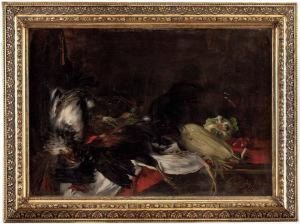Vilma Elisabeth Lwow Von Parlaghy Brochfeld Paintings
Vilma Lwoff-Parlaghy, also known as Princess Lwoff-Parlaghy, was a notable portrait painter born in 1863 in Hungary. She was born into an aristocratic family, which gave her the title of 'Princess,' though it is her artistic achievements that have left a more enduring legacy.
Vilma demonstrated her artistic talent early on, and she was fortunate to receive formal training in the arts. She studied at various European art academies, including those in Munich and Paris, which were leading centers for art education during the late 19th century. Her education and aristocratic background enabled her to move within the upper echelons of society, which proved beneficial for her career as a portrait artist.
Throughout her lifetime, Vilma Lwoff-Parlaghy became renowned for her ability to capture the likenesses and personalities of her sitters, who were often from the elite social circles of Europe and America. Her portraits were known for their realism and attention to detail, which was achieved through her skilled brushwork and understanding of color and light.
After establishing herself in Europe, Lwoff-Parlaghy moved to the United States in the early 20th century. She quickly gained fame in America, especially in New York City, where she continued to paint portraits of notable figures, including presidents, industrialists, and socialites. Her work was exhibited in prominent venues and received considerable acclaim, helping her to secure a place among the notable portrait artists of her time.
Despite her success, Vilma Lwoff-Parlaghy's personal life was marked by tragedy and eccentricity. She had a brief and unhappy marriage to a man named Frederick Von Brochfeld, which ended in divorce. Her later life was characterized by a reclusive lifestyle, during which she was often in the company of her pet lion, Goldfleck, whom she famously had as a constant companion.
Vilma Lwoff-Parlaghy passed away in 1923, leaving behind a legacy as a gifted portraitist who captured the visages of some of the most influential personalities of her era. Her works continue to be studied and appreciated for their artistic merit and the glimpse they provide into the society of her time.
